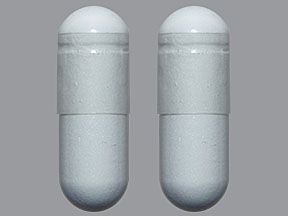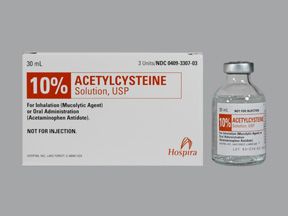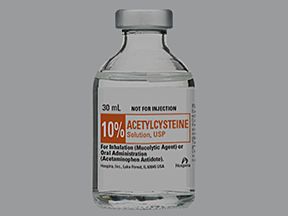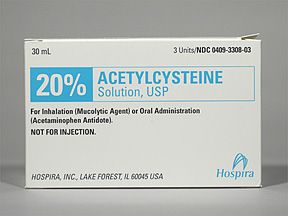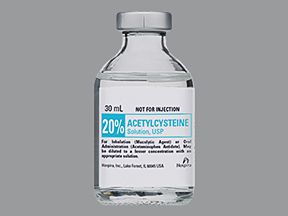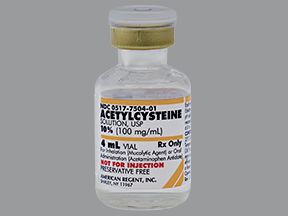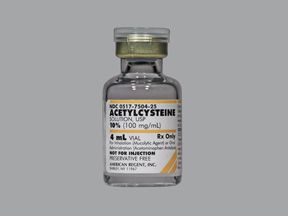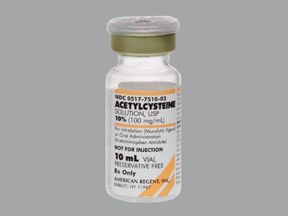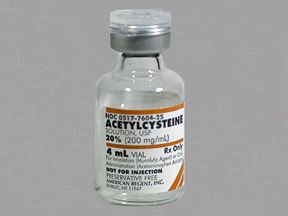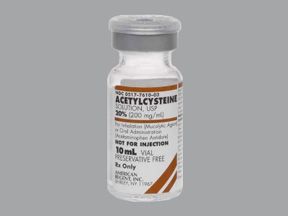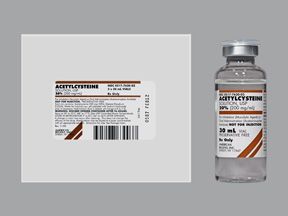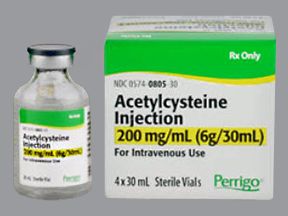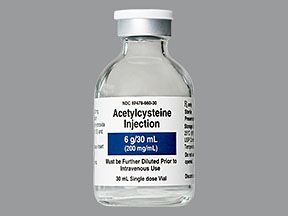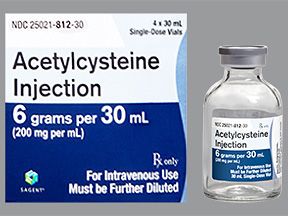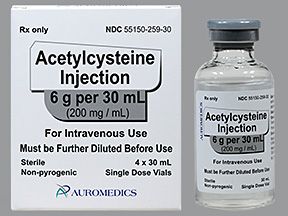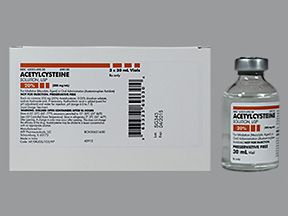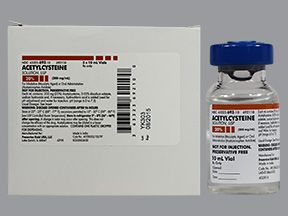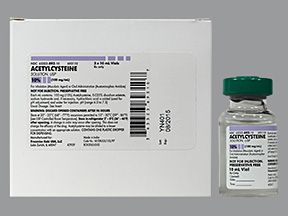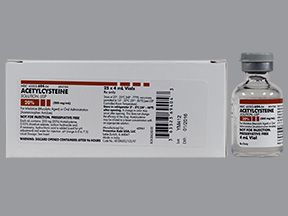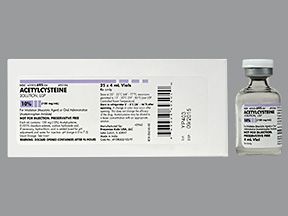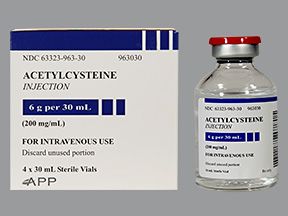Highlights for acetylcysteine
- Acetylcysteine inhalation solution is only available as a generic drug.
- Acetylcysteine comes in three forms: inhalation solution, injectable solution, and oral effervescent tablet.
- Acetylcysteine inhalation solution is used to help break up thick, sticky mucus that can form in your airways if you have certain diseases. These diseases include bronchitis, pneumonia, emphysema, asthma, cystic fibrosis, and tuberculosis.
- Warning for people with asthma: Make sure someone is with you when you take acetylcysteine. You’re at increased risk of wheezing, tightness in your chest, and trouble breathing (bronchospasm) after inhaling this drug.
Acetylcysteine is a prescription drug. It comes in three forms: inhalation solution, injectable solution, and oral effervescent tablet. (An effervescent tablet can be dissolved in liquid.)
Acetylcysteine inhalation solution is only available as a generic drug. Generic drugs usually cost less than brand-name drugs.
To take this drug, you inhale it. You need to use a nebulizer, which is a machine that turns this drug into a mist that you breathe in.
Acetylcysteine inhalation solution can be used as part of a combination therapy. This means you may need to take it with other medications. However, don’t mix acetylcysteine with other drugs in a nebulizer. This use hasn’t been studied.
Why it’s used
Acetylcysteine inhalation solution is used to help break up the thick, sticky mucous that can form in your airways if you have certain diseases. These diseases include:
How it works
Acetylcysteine belongs to a class of drugs called mucolytics. A class of drugs is a group of medications that work in a similar way. These drugs are often used to treat similar conditions.
Acetylcysteine reacts with the chemicals in mucous to make it less sticky and easier to cough up. This will help clear your airways and make it easier for you to breathe.
Acetylcysteine inhalation solution can make you drowsy. It can also cause other side effects.
More common side effects
Some of the more common side effects that can occur with use of acetylcysteine include:
- increased coughing (as acetylcysteine breaks up the mucous in your airways)
- mouth sores or painful swelling
- nausea
- vomiting
- fever
- runny nose
- clamminess
- chest tightness
- wheezing
If these effects are mild, they may go away within a few days or a couple of weeks. If they’re more severe or don’t go away, talk to your doctor or pharmacist.
Serious side effects
Call your doctor right away if you have serious side effects. Call 911 if your symptoms feel life-threatening or if you think you’re having a medical emergency. Serious side effects and their symptoms can include the following:
- Bronchospasm. Symptoms can include:
- wheezing
- tightness in your chest
- trouble breathing
Disclaimer: Our goal is to provide you with the most relevant and current information. However, because drugs affect each person differently, we cannot guarantee that this information includes all possible side effects. This information is not a substitute for medical advice. Always discuss possible side effects with a healthcare provider who knows your medical history.
Acetylcysteine inhalation solution may interact with other medications, vitamins, or herbs you may be taking. An interaction is when a substance changes the way a drug works. This can be harmful or prevent the drug from working well.
To help avoid interactions, your doctor should manage all of your medications carefully. Be sure to tell your doctor about all medications, vitamins, or herbs you’re taking. To find out how this drug might interact with something else you’re taking, talk to your doctor or pharmacist.
Disclaimer: Our goal is to provide you with the most relevant and current information. However, because drugs interact differently in each person, we cannot guarantee that this information includes all possible interactions. This information is not a substitute for medical advice. Always speak with your healthcare provider about possible interactions with all prescription drugs, vitamins, herbs and supplements, and over-the-counter drugs that you are taking.
This drug comes with several warnings.
Allergy warning
Acetylcysteine can cause a severe allergic reaction. Symptoms can include:
- trouble breathing
- swelling of your throat or tongue
If you develop these symptoms, call 911 or go to the nearest emergency room.
Don’t take this drug again if you’ve ever had an allergic reaction to it. Taking it again could be fatal (cause death).
Warning for people with asthma
After inhaling this drug, you’re at increased risk of wheezing, tightness in your chest, and trouble breathing. Make sure someone is with you when you take acetylcysteine.
Warnings for other groups
For pregnant women: Acetylcysteine is a category B pregnancy drug. That means two things:
- Studies of the drug in pregnant animals have not shown a risk to the fetus.
- There aren’t enough studies done in pregnant women to show if the drug poses a risk to the fetus.
Talk to your doctor if you’re pregnant or planning to become pregnant. This drug should only be used if the potential benefit justifies the potential risk to the fetus.
For women who are breastfeeding: Acetylcysteine may pass into breast milk. This may cause side effects in a child who is breastfed. Talk to your doctor if you breastfeed your baby. You may need to decide whether to stop breastfeeding or stop taking this drug.
All possible dosages and drug forms may not be included here. Your dosage, drug form, and how often you take the drug will depend on:
- your age
- the condition being treated
- the severity of your condition
- other medical conditions you have
- how you react to the first dose
Forms and strengths
Generic: Acetylcysteine
- Form: Inhaled solution
- Strengths: 10% (100 mg/mL) solution or 20% (200 mg/mL) solution
Dosage for breaking up mucous in your airways
Adult dosage (ages 18 years and older)
- Nebulized into a face mask, mouth piece, or tracheostomy. The recommended dosage for most people is 3–5 mL of the 20% solution, or 6–10 mL of the 10% solution, three to four times per day. However, doses can range from 1–10 mL of the 20% solution or 2–20 mL of the 10% solution. These doses may be given every two to six hours.
- Nebulized into a tent. You will need to use enough acetylcysteine (10% or 20%) to maintain a heavy mist in the tent for the length of time your doctor prescribes. You may use as much as 300 mL of acetylcysteine during a single treatment.
Child dosage (ages 0–17 years)
It has not been confirmed that this drug is safe and effective for use in children younger than 18 years. It should not be used for children in this age group.
Disclaimer: Our goal is to provide you with the most relevant and current information. However, because drugs affect each person differently, we cannot guarantee that this list includes all possible dosages. This information is not a substitute for medical advice. Always speak with your doctor or pharmacist about dosages that are right for you.
The acetylcysteine solution may change color after you open the vial of medication. This won’t change how well the drug works.
Acetylcysteine is used for short- or long-term treatment. The length of treatment will depend on your condition.
This drug comes with risks if you don’t take it as prescribed.
If you stop taking the drug or don’t take it at all: Symptoms such as wheezing and trouble breathing may get worse.
If you miss doses or don’t take the drug on schedule: Symptoms such as wheezing and trouble breathing may get worse if you don’t take this drug as directed by your doctor. Talk to your doctor if you think it isn’t working as well for you anymore. Don’t change how often you take it without talking with your doctor.
If you take too much: Since you inhale acetylcysteine, it acts mainly in your lungs and an overdose isn’t likely. If you find that this drug isn’t working as well for you anymore and you’re using it more frequently than usual, call your doctor.
What to do if you miss a dose: Take your dose as soon as you remember. If you remember just a few hours before your next scheduled dose, take only one dose. Never try to catch up by taking two doses at once. This can cause increased side effects.
How to tell if the drug is working: You will cough up more mucus. Symptoms such as wheezing and trouble breathing should get better.
Keep these considerations in mind if your doctor prescribes acetylcysteine for you.
Storage
- Store unopened acetylcysteine vials at room temperature. Keep them at temperatures ranging from 68°F to 77°F (20°C to 25°C). Keep them away from high temperatures.
- If you open a vial and use only some of the solution inside it, store the rest in a refrigerator. Use it within four days.
- If you need to dilute your dose, be sure to use the diluted solution within one hour.
Refills
A prescription for this medication is refillable. You should not need a new prescription for this medication to be refilled. Your doctor will write the number of refills authorized on your prescription.
Travel
When traveling with your medication:
- Always carry your medication with you. When flying, never put it into a checked bag. Keep it in your carry-on bag.
- Don’t worry about airport X-ray machines. They can’t hurt your medication.
- You may need to show airport staff the pharmacy label for your medication. Always carry the original prescription-labeled container with you.
- Don’t put this medication in your car’s glove compartment or leave it in the car. Be sure to avoid doing this when the weather is very hot or very cold.
Self-management
Checking lung function: Your doctor may have you check how well your lungs are working. To do this, you’ll perform a peak expiratory flow rate (PEFR) test using a device called a peak flow meter. Your doctor may also ask you to record your symptoms.
Using a nebulizer: To take this drug, you need to use a nebulizer. A nebulizer is a machine that turns the drug into a mist that you inhale. Not all nebulizers work in the same way. Your doctor will tell you which type to use and will show you how to use it.
Clinical monitoring
Your doctor will check your lung function with pulmonary function tests. These are breathing tests.
Availability
Not every pharmacy stocks this drug. When filling your prescription, be sure to call ahead to make sure your pharmacy carries it.
Hidden costs
You need a nebulizer to use this drug at home. A nebulizer is a machine that turns the liquid solution into a mist, which can then be inhaled. Most insurance companies will cover the cost of a nebulizer.
Depending on your condition, you may need to buy a peak flow meter. You can buy a peak flow meter at your local pharmacy.
There are other drugs available to treat your condition. Some may be better suited for you than others. Talk to your doctor about other drug options that may work for you.
Disclaimer: Healthline has made every effort to make certain that all information is factually correct, comprehensive, and up-to-date. However, this article should not be used as a substitute for the knowledge and expertise of a licensed healthcare professional. You should always consult your doctor or other healthcare professional before taking any medication. The drug information contained herein is subject to change and is not intended to cover all possible uses, directions, precautions, warnings, drug interactions, allergic reactions, or adverse effects. The absence of warnings or other information for a given drug does not indicate that the drug or drug combination is safe, effective, or appropriate for all patients or all specific uses.

